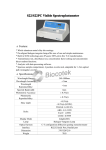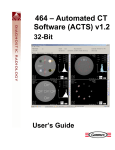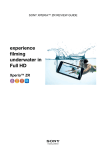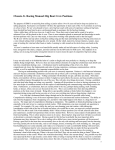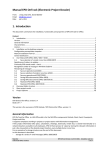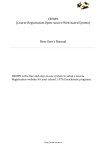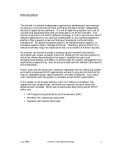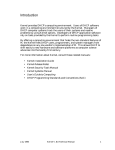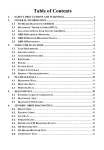Download SIF Test Harness User Manual: SIF 2 Enabled
Transcript
SIF Test Harness User Manual: SIF 2 Enabled Applications April 2012 V1.0 Contents Testing (SIF 2 Enabled Application Test Harness) ......................................................................................................3 Introduction .............................................................................................................................................................3 Accessing ................................................................................................................................................................3 Locating ..................................................................................................................................................................3 Understanding Expectations ...................................................................................................................................4 What Your Product Offers .......................................................................................................................................4 Login .....................................................................................................................................................................15 The Exception .......................................................................................................................................................15 Test Session .........................................................................................................................................................16 Submitting Results ................................................................................................................................................17 Further Assistance ................................................................................................................................................17 Page 2 Testing (SIF 2 Enabled Application Test Harness) Introduction The key to any certification is demonstrating mastery, so it should be no surprise that this holds true for SIF Certified Products. The SIF Association makes available to all its members the SIF Test Harness for both informal testing and testing in order to acquire a certification. This chapter will walk you through all the steps in testing your product. Accessing In order to use the Test Harness you must first secure a login to the SIF Community Site by following the directions found here: http://www.sifassociation.org/us/community.asp Locating The second incarnation of the SIF Test Harness can be found at: http://compliance.sifinfo.org/sifcompliance/home.jsp Once there you will be presented with many Test Suites for your use. Only Test Suites with a SIF logo in the first column may be used for formal certification testing. Page 3 Understanding Expectations Once you make your selection, there are several components to testing that you need to pay attention to. http://compliance.sifinfo.org/sifcompliance/productStandard.jsp?id=SIF+2+Enabled+Application+2.3-1 The Product Standard is the requirements above and beyond the specification that your product must adhere to in order to become certified. What Your Product Offers While there is a core SIF Infrastructure that all products must comply with, there are many choices to be made for: supported infrastructure components, completely optional technologies, objects and elements that are supported. These valid choices must be represented in fair testing of your software, so you must disclose these to the Test Harness. In addition this information will become public knowledge once your product is certified in order to inform customers of your software’s SIF capabilities. To do this, you must complete and submit a Conformance Statement Questionnaire (CSQ) which also carries critical branding and versioning information. In order to create a CSQ use the controls pictured here (note: they are located on the bottom left of the Test Suites front page). While the optional elements you declare support for are not required to appear in your data objects during testing, remember that: you warranty these capabilities and failing to disclose elements that you do support may result in loss of sales. http://compliance.sifinfo.org/sifcompliance/CSQEditor/new.jsp?csq=SIF+2+Enabled+Application&version=2.3-1 Page 4 Consider reading the introductory text at least once. We may attempt to contact the author if problems arise. Page 5 Note: The Versions here must match those in the Certification Agreement and should reflect your company’s plans for long term support changes in version support require retesting and the associated additional fee. Page 6 This information helps others know rough requirements for running your software. Page 7 Note: If you are experiencing trouble getting SSL/TLS working correctly we provide a utility to help at: http://compliance.sifinfo.org/sslhello/ Push: An agent that supports push mode provides a network service that the ZIS uses to contact the agent whenever it has a message for it. Pull: The agent that supports pull mode can be strictly a client; it uses a particular message to retrieve messages out of its queue on the ZIS. Page 8 Note: In the SIF Zone, every agent to agent message is dispatched to and routed by the Zone Integration Server (ZIS). It therefore may not be enough to demand a high level of encryption and security on any message sent to the ZIS. You may optionally demand the same level of security on the connection between the ZIS and every partner agent to which your message is being dispatched. This is done by setting the Authentication Level (above) and the Encryption Level (below). Page 9 Page 10 Note: Under Error Handling, “Yes” represents proper behavior. MaxBufferSize: SIF agents receive data response messages of various sizes based upon the requests for data they issue. In order to prevent a response message from overrunning a recipient’s buffer, the response is broken into multiple packets before the requesting agent receives it. This means, during registration, the recipient must provide the maximum buffer size it can accept. Note: This information must be accurate in order to ensure interoperability. For further details about filling out this section accurately you should see the infrastructure section/document of the version your agent is written to. Page 11 The table below is used to capture the types of SIF data your agent/application supports, and the way in which it uses that data to interoperate with other SIF Certified applications. For each row: The first column represents the name of a SIF data object. Data can be queried and responded to. The next three columns indicate, for this object, whether your application/agent does either or both. When the data for an object changes, or when it is desired to change that data, an event for the object type can be published, whereupon the event will be sent to all agent/applications which had previously subscribed. The next set of columns indicate whether your application will publish or subscribe (or do both) to such events for this object type, and is further divided into the three types of events (so for example your agent may only publish an event when a new object of this type is created). The final column indicates that your application provides a facility to align its data with the data in the zone. This can be done through a series of queries and is a critical feature for subscribers, utilized whenever your application is brought into the zone. Note: This information is also critical for those considering your product. Page 12 The table below is the most detailed part of the CSQ. It provides the level of detail necessary to flag interoperability issues between two SIF Certified applications (as for example if one or more optional elements in an object is needed by Application A, but not supplied by Application B). Note: Optional elements are not required to appear during testing, however they are validated when they do appear. Page 13 Note: For further details about filling out this section accurately you should see the infrastructure section/document of the version your agent is written to. Note: Use the link to download the conformance statement you just created. Page 14 Login Now return to the front page of the selected Test Suite with our CSQ and credentials. The Exception Support of the mandatory TLS 1.0 cipher suite has (in practice) proven to be unnecessary; therefore we allow it to go untested. Page 15 Test Session A. The encryption information is one of the most common areas to cause confusion; please read the provided document. Our certificates are self-signed and need to be trusted. B. The Agent Configuration information is based on responses previously given to us. If they do not accurately reflect your software, please edit your CSQ. C. The ZIS Info is based on the SIF Association’s ZIS which has configured a Zone for your Test Session; you must configure your software to work with it. Page 16 D. Once you fail one of these tests the only way to satisfy it is to start over with a new Test Session. E. While there is nothing wrong with seeing a few messages in the queue, this provides a clear view if messages are backing up. F. This is the log of the ZIS, pay attention to the source when analyzing these messages (your software is not alone in this zone). G. Two things to note here. The first is that in order to monitor your testing progress you will have to refresh your browser. Second, once you are done with your testing you will need to “End” the Test Session in order to submit the results. H. This control can be used to cause all actions that need to be initiated by the Test Harness to begin; however it cannot control your software, so even after handling all of this properly some tests may remain. Be sure to know which actions in your software will trigger what SIF traffic! I. From here on down are controls that allow you to micromanage what comes from the Test Harness, enabling you to address one test at a time. Submitting Results If you would like to submit your results for certification, use the link at the bottom of the Certification section. Please “Close” the Test Session when you are done. Further Assistance Test Harness FAQ: http://compliance.sifinfo.org/sifcompliance/docs/faq.html Official Email: [email protected] Page 17

















